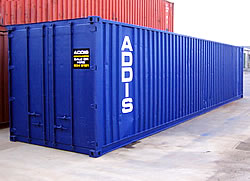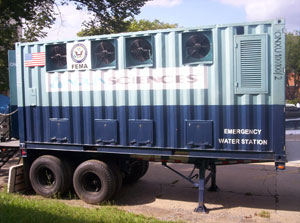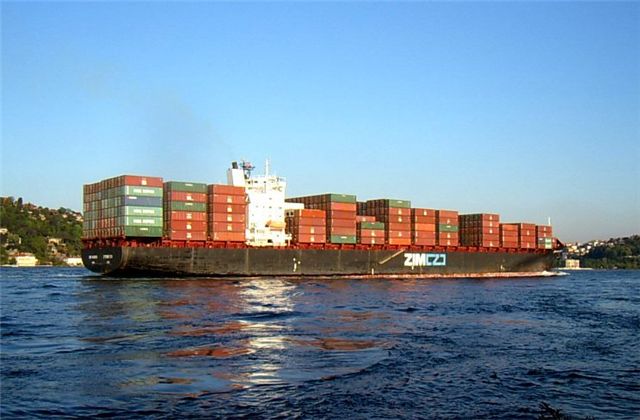Shipping Containers and Standardization
by billhilf on November 28, 2006 01:51am
I’m sitting in Istanbul watching ships – big ships with huge loads of containers on board. I recently finished a great book titled The Box, How the Shipping Container Made the World Smaller and the World Economy Bigger, Marc Levinson (2006), a fascinating analysis of the history of the shipping container. It may sound dry, but it’s a very interesting story – particularly of the entrepreneur, Malcom McLean, who challenged the norm and introduced standardized, packaged shipping; transforming commercial shipping from a costly, labor intensive and inefficient system into a booming industry that radically dropped the cost of transporting goods around the world.

If you are in the software or IT industry, it’s near impossible to read this book and not correlate many of the concepts of ‘containerization’ or standardization to the technology world. Almost all containers today that you see on ships, trains or in loading yards, are between 40 ft (12.2 m) and 45 ft (13.7 m). Typically, most are 40-ft and have a capacity of 2 TEU (twenty-foot equivalent units). The reason for the massive change in both transportation and the global economy is because of this simplicity of size – a small set of standard sizes that allowed ships, trucks, receiving bays, and all of the logistical systems related to easily adapt to an industry wide standard.
Prior to containerization, there were major inefficiencies in commercial shipping. Packaging and crating was inconsistent – “breakbulk’ cargo consisted of separate items that had to be handled individually, such as bags of sugar or flour packed next to steel piping. The type and shapes of the shipping vessels were not designed for efficiency: wide at the top and narrow at the bottom. All of this resulted in the large use of manual labor to absorb the inefficiencies in the process. See clip 3 to watch Levinson describe why trade was so difficult prior to containerization.
Standardization of containers resulted in tremendous efficiencies and unlocked the interoperability between the things that transported the containers and the tools, machines and facilities that need to send and receive these containers and their contained goods. How big of a change did this standardization make?
Today, approximately 90% of non-bulk cargo worldwide moves by containers stacked on transport ships. Some 18 million total containers make over 200 million trips per year. For the past ten years, demand for cargo capacity has been growing almost 10% a year. There are ships that can carry over 11,000 TEU ("Emma Mærsk", 1,300 feet long), and designers are working on freighters capable of 14,000 TEU. At some point, container ships will be constrained in size only by the Straits of Malacca, one of the world's busiest shipping lanes. There are plans underway for a quarter-mile-long ship, called the Malacca-Max, targeting a capacity of 18,000 containers (for scope, it would take $1 billion in cargo down with it if it sank).
When I talk with customers, repeatedly they are looking for a way to simplify. They are looking to get more things done (and faster) with less complexity and costs in their environment – science projects are not what they are looking to experiment with. Moreover, the last IT director I talked with is using this as an interviewing tool – testing the interested candidates for their ‘appetite’ for standardization versus highly customized, highly variant systems. Granted, there is always a need for some type of customization and variation, it’s not a question of ‘if’ but of ‘how much’, ‘where’, and ‘why?’ These questions are critical and each needs to have real business value described in the answer. Building a business on a standard platform helps facilitate this simplification and unlocks interoperability for IT. It is an important IT policy that I have employed in the past and many IT leaders I know use this as a core part of the IT strategy.
 Standardization in shipping containers created an entire industry – literally grown around this concept of a standard ‘platform’. Beyond the core shipping industry itself (logistics, supply chain, services, ship-to-gound transport, etc.) people are starting to ‘hack’ the shipping container standardization model. Sun announced a data center in a shipping container – interesting proposal, but limited IMHO (maybe they should GPL it J). I find AquaSciences (picture on the left) one of the most fascinating ideas: using containers for fully-contained mobile freshwater generation systems. Quite easy to see the potential of this and it literally could save lives. Of course, there are people building living spaces out of containers, such as Freitag’s ‘skyscrapers’ in Zurich. Here’s a list of all sorts of shipping-container-as-house ideas.
Standardization in shipping containers created an entire industry – literally grown around this concept of a standard ‘platform’. Beyond the core shipping industry itself (logistics, supply chain, services, ship-to-gound transport, etc.) people are starting to ‘hack’ the shipping container standardization model. Sun announced a data center in a shipping container – interesting proposal, but limited IMHO (maybe they should GPL it J). I find AquaSciences (picture on the left) one of the most fascinating ideas: using containers for fully-contained mobile freshwater generation systems. Quite easy to see the potential of this and it literally could save lives. Of course, there are people building living spaces out of containers, such as Freitag’s ‘skyscrapers’ in Zurich. Here’s a list of all sorts of shipping-container-as-house ideas.
Standardization was the key to success. As I sit here in Istanbul, watching literally hundreds of container ships make their way through the Bosporus from the Black Sea to the Sea of Marmara (which is connected by the Dardanelles to the Aegean Sea, and thereby to the Mediterranean Sea), I can’t help but marvel at how such a simple concept – the standardization of the shipping container – made such a radical and important change to the global economy and our lives. I don’t think it’s circumstantial that standardization made things cheaper and easier (two words Levinson uses in his closing sentence of ‘The Box’). Here’s to great ideas and to getting more work done with less complexity.
-bill
P.S:
1. video interviews with ‘The Box’ author Marc Levinson
2. Industry standards and platform standardization are important in software development as well as the datacenter – for an example see this article on “Using IEEE Standards to Support America’s Army Gaming Development”